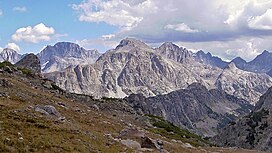| Ladd Peak | |
|---|---|
 West aspect, centered | |
| Highest point | |
| Elevation | 12,967 ft (3,952 m) [1] |
| Prominence | 660 ft (201 m) [1] |
| Parent peak | Mount Whitecap (13,025 ft) [1] |
| Isolation | 0.66 mi (1.06 km) [1] |
| Coordinates | 43°10′30″N 109°42′08″W / 43.1750488°N 109.7021922°W [2] |
| Naming | |
| Etymology | Dr. William S. Ladd (1887–1949) |
| Geography | |
| Country | United States |
| State | Wyoming |
| County | Sublette |
| Protected area | Bridger Wilderness |
| Parent range |
Rocky Mountains Wind River Range [3] |
| Topo map | USGS Gannett Peak |
| Geology | |
| Type of rock | granitic |
| Climbing | |
| First ascent | 1921 [4] |
| Easiest route | class 3 scrambling East Ridge [4] |
Ladd Peak is a 12,967-foot-elevation (3,952-meter) mountain summit in Sublette County, Wyoming, United States. [2]
Description
Ladd Peak is located in the remote Wind River Range, which is a subrange of the Rocky Mountains. It is set 2.35 miles (3.78 km) west of the Continental Divide within the Bridger Wilderness, on land managed by Bridger-Teton National Forest. The nearest town is Pinedale, 23 miles (37 km) to the south-southwest. Ladd Peak ranks as the 40th-highest peak in Wyoming and is 2.5 miles (4.0 km) west of Gannett Peak, the highest peak in Wyoming. [1] Precipitation runoff from the mountain drains into headwaters of the Green River. Topographic relief is significant as the summit rises nearly 3,600 feet (1,100 meters) above the river in 1.25 mile (2 km) and the 4,500-foot rise above Three Forks Park is the largest rise in the Wind River Range. [4]

History
The first ascent of the summit was made in 1921 by Dr. William S. Ladd, Evans Clark, Freda Kirchwey, and Dr. Adolf Schultz via the East Ridge. [3] [4] [5] The North Couloir was first climbed in 1974 by Stan Hilbert and Bill March. [4] The mountain's toponym has been officially adopted by the United States Board on Geographic Names. [2]
William S. Ladd
In addition to making the first ascent of this peak, Dr. Ladd is also credited with first ascents of Mount Saskatchewan and North Twin Peak in Canada. An avid mountaineer, he served as president of the American Alpine Club from 1929 through 1931. [6] He was born in Portland, Oregon, on August 16, 1887, and died unexpectedly on September 17, 1949.
Climate
According to the Köppen climate classification system, Ladd Peak is located in an alpine subarctic climate zone with long, cold, snowy winters, and cool to warm summers. [7] Due to its altitude, it receives precipitation all year, as snow in winter and as thunderstorms in summer.
Hazards
Encountering bears is a concern in the Wind River Range. [8] There are other concerns as well, including bugs, wildfires, adverse snow conditions and nighttime cold temperatures. [9]
Importantly, there have been notable incidents, including accidental deaths, due to falls from steep cliffs (a misstep could be fatal in this class 4/5 terrain) and due to falling rocks, over the years, including 1993, [10] 2007 (involving an experienced NOLS leader), [11] 2015 [12] and 2018. [13] Other incidents include a seriously injured backpacker being airlifted near Squaretop Mountain [14] in 2005, [15] and a fatal hiker incident (from an apparent accidental fall) in 2006 that involved state search and rescue. [16] The U.S. Forest Service does not offer updated aggregated records on the official number of fatalities in the Wind River Range.
See also
References
- ^ a b c d e "Ladd Peak - 12,967' WY". listsofjohn.com. Retrieved 2023-07-15.
- ^ a b c "Ladd Peak". Geographic Names Information System. United States Geological Survey, United States Department of the Interior. Retrieved 2023-07-15.
- ^ a b "Ladd Peak, Wyoming". Peakbagger.com. Retrieved 2023-07-15.
- ^ a b c d e Joe Kelsey, Climbing and Hiking in the Wind River Mountains, Rowman & Littlefield (2013), ISBN 9781493001354, p. 164, 421.
- ^ Appalachia Volume 19, Appalachian Mountain Club (1932), p. 368.
- ^ William Sargent Ladd, 1887-1949, American Alpine Journal (1950), americanalpineclub.org
- ^ Peel, M. C.; Finlayson, B. L.; McMahon, T. A. (2007). "Updated world map of the Köppen−Geiger climate classification". Hydrol. Earth Syst. Sci. 11. ISSN 1027-5606.
- ^ Staff (April 24, 2017). "Bear Safety in Wyoming's Wind River Country". WindRiver.org. Retrieved February 17, 2019.
- ^ Ballou, Dawn (July 27, 2005). "Wind River Range condition update - Fires, trails, bears, Continental Divide". PineDaleOnline News. Retrieved February 17, 2019.
- ^ Staff (1993). "Falling Rock, Loose Rock, Failure to Test Holds, Wyoming, Wind River Range, Seneca Lake". American Alpine Club. Retrieved February 15, 2019.
- ^ MacDonald, Dougald (August 14, 2007). "Trundled Rock Kills NOLS Leader". Climbing. Retrieved February 15, 2019.
- ^ Staff (December 9, 2015). "Officials rule Wind River Range climbing deaths accidental". Casper Star-Tribune. Retrieved February 15, 2019.
- ^ Dayton, Kelsey (August 24, 2018). "Deadly underestimation". WyoFile News. Retrieved February 15, 2019.
- ^ Funk, Jason (2009). "Squaretop Mountain Rock Climbing". Mountain Project. Retrieved March 29, 2019.
- ^ Staff (July 22, 2005). "Injured man rescued from Square Top Mtn - Tip-Top Search & Rescue helps 2 injured on the mountain". PineDaleOnline News. Retrieved February 17, 2019.
- ^ Staff (September 1, 2006). "Incident Reports - September, 2006 - Wind River Search". WildernessDoc.com. Retrieved February 17, 2019.
External links
- William Ladd in memoriam: Americanalpineclub.org
- Weather forecast: Ladd Peak

